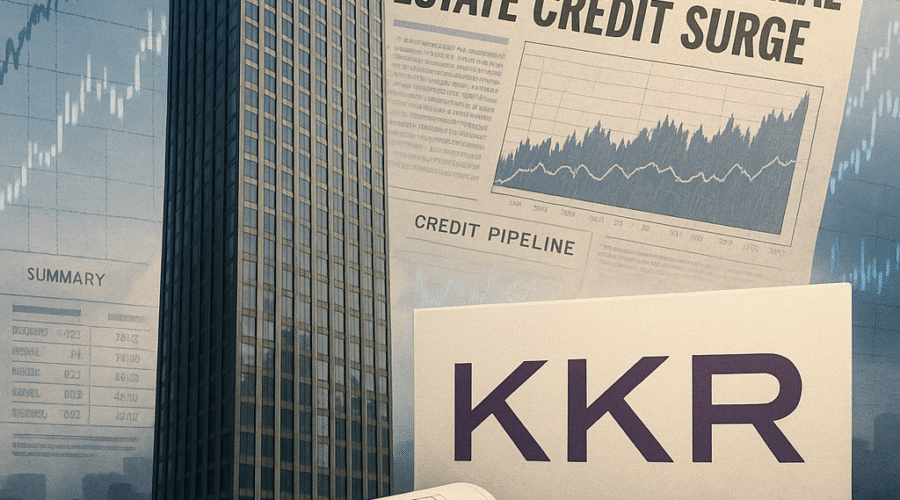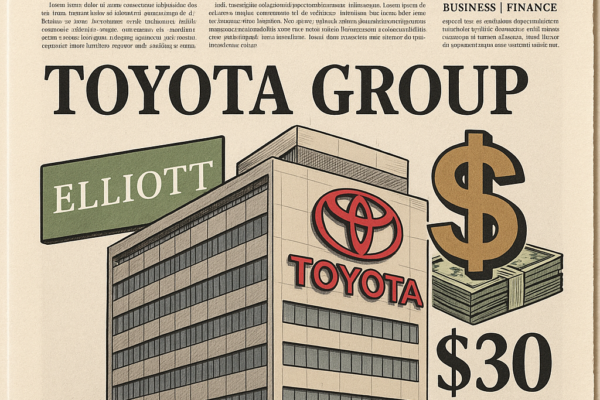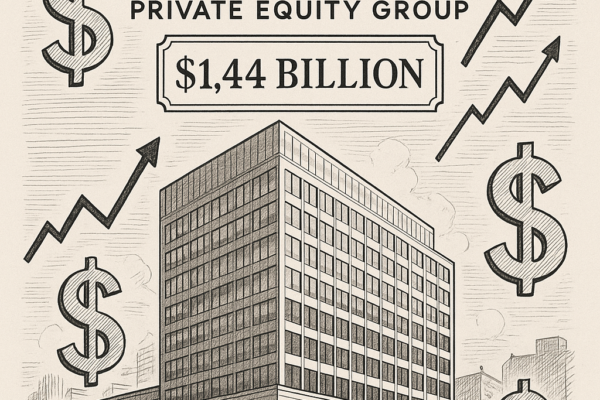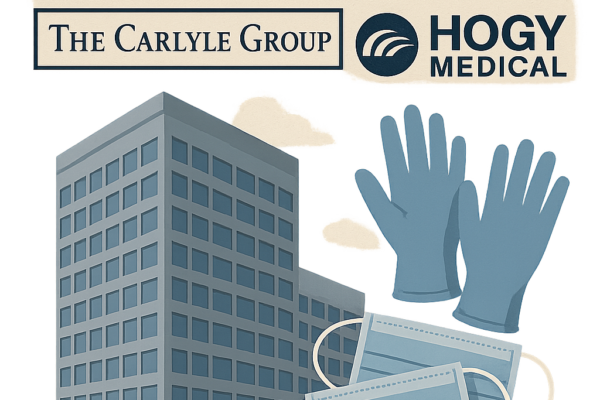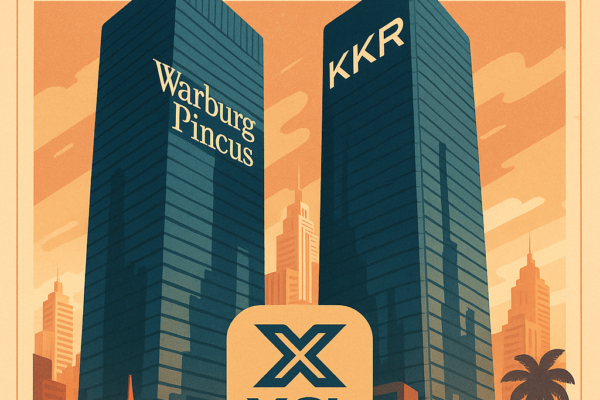As traditional lenders retreat from commercial real estate, KKR has amassed a record $42 billion private credit pipeline – the largest in its history – positioning itself as the lender of last resort for institutional borrowers navigating tariff volatility and a $1.5 trillion debt maturity wall. This strategic buildup combines aggressive capital deployment with structural protections, offering 12-14% yields on loans secured by Class A properties while maintaining 60-70% loan-to-value ratios. The firm’s real estate credit AUM has tripled since 2023, fueled by $850 million in fresh fund commitments and a calculated bet that private lenders will capture 40% of the $500 billion bank lending gap by 2026.
💼 Seasoned CorpDev / M&A / PE expertise
The Anatomy of a $42 Billion Pipeline
Structural Advantages in Volatile Markets
KKR’s commercial real estate lending machine operates through three complementary strategies: $12 billion in CMBS positions targeting distressed securities[2], $9 billion in mezzanine debt yielding 10-12%[2], and $21 billion in senior floating-rate loans secured by institutional-grade properties[1][17]. This tripartite approach allows the firm to capture spreads ranging from 400 basis points on senior debt to 800+ bps in mezzanine tranches while maintaining 40% equity cushions[1][12]. The pipeline’s composition reflects strategic shifts – CMBS exposure doubled year-over-year as KKR capitalized on SASB delinquencies hitting 11% in Q4 2024[12][17].
Geographic and Sector Concentration
While 65% of deployments target Sun Belt multifamily and industrial assets[2][15], KKR is expanding its European footprint with $4 billion allocated to UK and Western European loans[8][9]. The firm recently closed its first German logistics park financing at 58% LTV, reflecting stricter underwriting in new markets[8]. Sector-wise, 47% of the portfolio backs multifamily properties, with life sciences (12%) and data centers (9%) emerging as growth verticals[5][15].
Market Forces Driving Private Credit Dominance
The $1.5 Trillion Refinancing Wall
With $1.5 trillion in commercial real estate debt maturing through 2026[18], KKR’s pipeline growth correlates directly with borrower distress. The firm reports 70% of current originations involve refinancings, often at 50-60% of peak valuations[2][5]. A recent $376 million loan package for Class A Manhattan offices carried a 13.7% yield – 380 bps higher than pre-tariff pricing – reflecting both risk and opportunity[8][12].
Bank Retreat Creates $500 Billion Void
Regulatory pressures have reduced bank CRE lending capacity by 22% since 2022, creating a funding gap that private lenders are filling at $140 billion annually[2][16]. KKR’s weekly deal flow surged from $14.5 billion in January 2024 to $20 billion by August[7], with 85% of transactions involving borrowers rejected by traditional lenders[12][17]. This dislocation allows 60-70% LTV loans on properties that would have commanded 80%+ LTVs in 2021[1][5].
KKR’s Countercyclical Playbook
Operational Alpha Generation
Unlike passive lenders, KKR’s 400-person real estate team actively repositions collateral – a vacant Dallas office complex securing a $320 million loan was converted to medical offices, boosting NOI 34% in nine months[15]. This hands-on approach reduces average vacancy rates across the portfolio to 8.7% versus 15.4% for CMBS benchmarks[5][12].
Liability-Driven Investing
The firm’s recent $850 million Opportunistic Real Estate Credit Fund II (ROX II) employs a barbell strategy – 60% in short-duration bridge loans (2-3 year terms) and 40% in 5-7 year CMBS positions[9][11]. This matches the yield curve inversion, capturing 14% returns on front-end exposures while maintaining duration optionality[2][12].
Risk Mitigation in an Uncertain Climate
Tariff Contingency Planning
Despite pipeline growth, KKR maintains 22% cash reserves – double its historical average – to absorb potential tariff-related shocks[1][8]. The firm’s stress testing shows current LTVs could withstand 35% valuation declines before triggering defaults, compared to 25% in 2021 underwriting[5][17].
Concentration Management
No single asset class exceeds 20% exposure, with strict limits on challenged sectors like regional malls (3%) and suburban offices (7%)[5][15]. The portfolio’s weighted average debt yield stands at 11.4%, providing 230 bps cushion against benchmark borrowing costs[5][8].
Competitive Landscape and Valuation Dynamics
Peer Activity Comparison
While Blackstone maintains its $8 billion real estate debt fund[1], KKR’s pipeline now triples its closest competitor’s volume[2][12]. The firm’s 13.7% average yield outperforms Apollo’s 11.9% and Ares’ 12.4% in similar strategies[2][9]. This premium reflects KKR’s willingness to finance complex recapitalizations – a recent Miami mixed-use deal involved mezzanine debt priced at LIBOR+900 bps with 2% origination fees[12].
Cap Rate Compression Signals
Multifamily cap rates have compressed 80 bps since Q4 2024 to 6.1%, suggesting private lenders may need to accept lower spreads as traditional buyers return[2][18]. KKR’s response – shifting 15% of pipeline capacity to life sciences and data centers where cap rates remain stable at 7-8%[5][15] – demonstrates adaptive portfolio management.
Strategic Implications for Institutional Investors
Yield Arbitrage Opportunities
KKR’s 12-14% target returns compare favorably to 6.8% average CRE equity IRRs, creating compelling risk-adjusted alternatives[2][18]. The firm’s European expansion offers additional alpha – UK senior loans price at 350 bps over SONIA versus 250 bps stateside[8][9].
Duration Matching Strategies
With 73% of loans featuring 3-5 year terms, the portfolio aligns with institutional LDI needs better than perpetual private equity funds[5][9]. KKR’s new seven-year term loan facility at SOFR+250 bps demonstrates capital markets confidence in this medium-duration approach[5][15].
Conclusion: Navigating the New Lending Paradigm
KKR’s unprecedented pipeline scale reflects both market dislocation and strategic foresight. By combining conservative underwriting (60-70% LTVs) with activist asset management, the firm achieves equity-like returns in senior debt positions. However, investors should monitor key risks – tariff impacts could increase construction costs 15-20%, while cap rate compression may force yield targets downward. As $1.5 trillion in maturing debt hits markets through 2026, KKR’s $42 billion war chest positions it to capture 8-10% market share in the private credit revolution reshaping global real estate finance.
Sources
https://commercialobserver.com/2025/06/kkr-commercial-loan-pipeline/, https://www.ainvest.com/news/real-estate-credit-opportunity-kkr-42b-pipeline-golden-ticket-rising-rate-world-2506/, https://www.ainvest.com/news/kkr-real-estate-finance-trust-q1-2025-key-contradictions-dividends-european-growth-market-activity-2505/, https://www.kkrfunds.com/wp-content/uploads/2024/07/KCOP-US-Presentation-1Q2024.pdf, https://www.sec.gov/Archives/edgar/data/1631596/000114036125008825/ny20041801x3_ars.pdf, https://www.kkr.com/alternatives-unlocked/private-real-estate, https://www.kkr.com/insights/real-estate-credit-opportunity, https://www.investing.com/news/transcripts/earnings-call-transcript-kkr-real-estate-q1-2025-eps-misses-stock-dips-93CH-4002339, https://alternativecreditinvestor.com/2025/02/17/kkr-closes-opportunistic-real-estate-credit-strategy-with-850m/, https://www.stblaw.com/about-us/news/view/2025/02/19/kkr-raises-over-$850-million-for-opportunistic-real-estate-credit-strategy, https://www.familywealthreport.com/article.php/What's-New-In-Investments,-Funds%3F-%E2%80%93-KKR--?id=203632, https://www.bisnow.com/national/news/capital-markets/kkrs-loan-pipeline-hits-42b-all-time-high-as-landlords-flock-toward-alternative-lending-129641, https://www.kkrfunds.com/wp-content/uploads/2023/03/KCOP-US-Presentation-Q4-2022_vF.pdf, https://www.madisonrealtycapital.com/uploads/application/files/cma060520.pdf, https://www.kkrreit.com/~/media/Files/K/KKR-V2/reports-and-presentations/kref-2q24-transcript.pdf, https://www.kkr.com/insights/real-estate-credit-gear-up, https://www.businesstimes.com.sg/property/kkr-builds-record-us42-billion-private-real-estate-loan-pipeline, https://www.kkr.com/insights/real-estate-recovery

